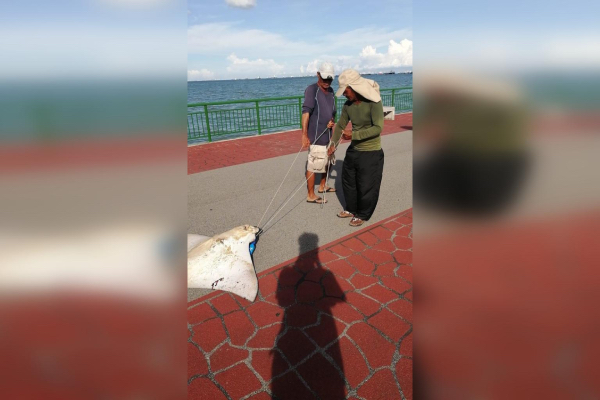'Let it go': Video of man reeling in endangered eagle ray at East Coast Park sparks concern


People gathered at the shore as they watched an angler reel in a big catch at East Coast Park.
In the thrill of the moment, however, they might not have noticed whether hauling an eagle ray — an endangered species — was the right thing to do.
A video clip of the incident was posted on Facebook last Friday (May 28), showing a man in red determinedly tugging at his fishing rod against an unseen fish in the water for nearly three minutes.
Three other people helped him as they pulled the fishing line, with one of them impaling a hook in the eagle ray's head before dragging it up the shore.
While the 10 or so bystanders were heard exclaiming when they saw what was on the end of the fishing line, many netizens voiced concern over what happened to the marine animal.
A Facebook user pleaded: "Please let it go" while another said that the video was "painful to watch". Several others identified the eagle ray and pointed out that it was an endangered species.


According to The Straits Times, the man who posted the video said the clip was sent to him by a friend and confirmed that the incident took place at the Bedok Jetty in East Coast Park.
The ray was caught on May 3 at 4.45pm, conservation group Marine Stewards Singapore told the publication.
A photo taken after the catch showed two men dragging the dead eagle ray along a pavement at the jetty.

The animal has been identified as the white-spotted eagle ray or Aetobatus Ocellatus, one of Singapore's three eagle ray species. It is categorised as a vulnerable species on the International Union for Conservation of Nature's Red List of Threatened Species.
According to Kelvin Lim, a curator of vertebrate collections at the Lee Kong Chian Natural History Museum in NUS, leisure anglers often cannot tell if they have caught an endangered fish.
If they do reel in an endangered species, he suggested that they should release it if the animal is still alive and not seriously injured.
"Animals do get injured when they are hooked, usually at the mouth... practitioners of catch and release believe that they are able to heal quickly," he added.
[[nid:497754]]
When a large fish is impaled by a big hook, however, it will suffer more grievous injuries, he explained.
NUS Marine Biologist Dr Huang Danwei said: "We ought to avoid interacting or getting too close to threatened species. Rather, admire from a distance where possible to minimise further harm to them, and to prevent injuries to ourselves."
Stingrays have venomous barbs on their tails that can inflict painful stings and notes that sightings of stingrays, jellyfish and other marine wildlife have increased in the past two years, he warned.
Last year, a massive stingray weighing 80kg was caught by leisure anglers at Bedok Jetty. The fish was later cut open and butchered. Identified as a Leopard Whipray, it too was a vulnerable species that was not released after being caught.